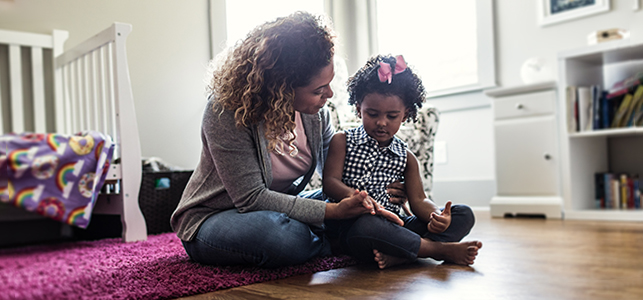It’s no secret that adults and teens experience anxiety, but it’s common in young kids too. We asked Dr. Dorothy O’Keefe, child psychiatrist at our Virginia Treatment Center for Children, how to identify anxiety in a little one and help them learn to navigate situations that make them uneasy.
Dr. O’Keefe talks anxiety in kids and how to help
How common is anxiety in young children?
Anxiety is the most common emotional problem in young kids. Types of anxiety children may experience include:
- Separation anxiety disorder – extreme distress being away from their caregivers or home, beyond what’s considered typical during the baby and toddler years
- Social anxiety disorder – fear of what others will think or say
- Generalized anxiety disorder – persistent and excessive worry over many things
- Selective mutism – refusal to speak in certain social situations, despite being talkative at home or in other settings
- Panic disorder – significant fears that cause panic attacks with physical symptoms (racing heart, shortness of breath, etc.), often without a known cause
- Specific phobias – irrational fear of an object or situation that leads to dread or avoidance
- Obsessive-compulsive disorder – performing repetitive rituals or routines in an effort to relieve anxiety and control unreasonable fears or worries (technically no longer in the category of anxiety disorders, but there is a strong component of anxiety that is warded off by the OCD behaviors)
What are some signs that a child may be feeling anxious?
An anxious child may:
- Have trouble sleeping
- Avoid certain situations
- Cling to parents
- Have tantrums
- Fidget or have trouble concentrating
- Complain of physical symptoms like stomachaches or headaches
- Be excessively compliant and fearful of making mistakes
What are some common causes/triggers of anxiety in young children?
It’s normal for all of us to feel anxious when there’s a threat in the environment. It is our brain signaling us to take protective action, just as thirst is a normal feeling when our body is telling us we need more water. Infants and toddlers commonly experience anxiety when separated from parents or caregivers. It’s not unusual for children to go through a period of being afraid of the dark, or of storms, but usually these behaviors don’t keep them from a normal range of activities.
However sometimes our brain’s anxiety system becomes over-reactive. This can happen for several reasons. Some people are just wired to be more cautious or sensitive to threats. This is often a hereditary characteristic, as anxiety disorders tend to run in families. Another reason is if our anxiety system gets activated by something scary that happens, it may stay “on the alert” for danger.
How can parents/guardians help their children manage anxiety?
It’s important to acknowledge the anxiety, and not to tease or belittle the child. At the same time, however, we don’t want to allow the anxiety to take over.
Here are a few ways to help an anxious child:
- Tell them it’s okay to feel anxious, but still allow them to enter the situation.
- Teach positive self-talk (“I think I can”).
- Remind them of other times they’ve done something hard.
- Tell them about a worry you had and how you learned to manage it.
- Try reading a book together about kids managing their anxiety and handling tough situations. There are some great books for young kids, including:
- Llama Llama Misses Mama by Anna Dewdney
- Ruby Finds a Worry by Tom Percival
- Wemberly Worried by Kevin Henkes
Are there certain things parents shouldn’t do when a child is experiencing anxiety?
It’s unwise to overprotect a child. Although it feels like you’re helping when you allow them to avoid or escape an age-appropriate challenge, it inadvertently confirms their fear. For example, letting a child consistently sleep with their parents sends the message, “You’re right, it IS too scary for you to sleep in your own bed.”
Avoidance is the natural human response to anxiety. It protects us from discomfort in the short run, but it actually reinforces the anxiety in the long run. Anxiety disorders are very treatable health conditions, but the longer avoidance habits go on, the more embedded they become, and the harder the child and family will have to work to recover.
When should parents be concerned about their child’s anxiety? When is it more than “normal” childhood anxiety?
The markers of when to seek help include when the child is:
- Persistently complaining of feeling bad
- Constantly worrying
- Unable to do age-appropriate activities, like go to school or a friend’s house, or be away from their parents
What should a parent do if they have concerns about anxiety and their child?
Seek an evaluation with a counselor who works with children; often your child’s pediatrician can suggest someone. A child psychiatrist can provide an evaluation, but there may be a longer wait for an appointment. The therapist can help determine if further care is needed.
What are some ways you and your colleagues help children with anxiety?
Anxiety is treated with:
- Therapy, usually cognitive behavioral therapy, which involves identifying the anxiety, learning strategies to manage the feeling, and then slowly increasing exposure to the anxiety stimulus to “teach” the brain that we can survive it.
- If the symptoms are more severe, we can use medication to decrease anxiety, most commonly SSRIs, which are usually thought of as “antidepressant” medications such as fluoxetine (Prozac) or sertraline (Zoloft).
